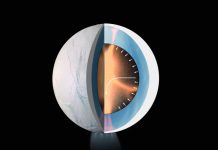A tiny satellite is on its mission to the Mars. It has recently captured a beautiful view of its home. The tiny satellite belongs to the NASA’s Mars Cube One (MarCO) cubesats. It was coupled with the NASA’s Insight Lander and was launched on May 05, 2018. It captured a photo on May 09, 2018. The tiny satellite was engineered to snap a picture when its high gain antenna develops entirely.
The snapped photo features the antenna, the moon, and the Earth. Interestingly, the Earth appears as a mere pale blue dot in the image. It resembles the Earth’s image when it was snapped back in 1990. The picture courtesy for the 1990 image goes to the NASA’s voyager one probe.
Andy Klesh says, “Cubesats have never gone this far into space before, so it’s a big milestone. Both our cubesats are healthy and functioning properly. We’re looking forward to seeing them travel even farther.” Klesh is the chief engineer at the NASA’s Jet Propulsion Laboratory (JPL). The JPL is present in the Pasadena in California.
Instead of the pale blue dot resemblance, there is currently no such similarities between the Cubesats (MarCO-A and MarCO-B) and the Voyager 1 of 1990. The Voyage 1 took the image when it was at a distance of 3.7 billion miles from the Earth. However, the two cubesats (MarCO-A and MarCO-B) were at a distance of about 620,000 miles from the Earth on May 08, 2018.
Cubesats are now common orbiting around the Blue Planet. Its primary role is to test the technologies, study, and the capture of the Earth’s image. Also, to these, it also performs other specific tasks. Unless the twin MarCO spacecraft evolution, no other cubesats had ever been to deep space.
MarCO-A and Marco-B were built at the NASA’s Jet Propulsion Laboratory. The primary aim of the twin MarCO spacecraft is to show that the cubesats can explore the faraway destination in space. If everything falls in place, the twin MarCO spacecraft will make its way to Mars on November 26, 2018. Once at the Mars, the shuttle is scheduled for the health check-up before the mission is called off.





